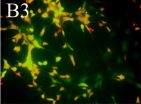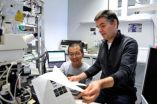(Press-News.org) A new microfluidic method for evaluating drugs commonly used for preventing heart attacks has found that while aspirin can prevent dangerous blood clots in some at-risk patients, it may not be effective in all patients with narrowed arteries. The study, which involved 14 human subjects, used a device that simulated blood flowing through narrowed coronary arteries to assess effects of anti-clotting drugs.
The study is the first to examine how aspirin and another heart attack prevention drug respond to a variety of mechanical blood flow forces in healthy and diseased arteries. Patients' blood was tested in a patent-pending microfluidic device with narrow passageways to simulate the coronary arteries. The data are consistent with clinical findings showing that physiology has a major influence on the effectiveness of drugs used for heart attack prevention.
The researchers believe that a benchtop diagnostic device like the one used in this study could save lives by preventing heart attacks and help lower healthcare costs by giving physicians better guidance on how drugs may affect individual patients.
"Doctors have many drug options and it is difficult for them to determine how well each of those options is going to work for a patient," said Melissa Li, who was a graduate student at the Georgia Institute of Technology at the time of the study. "This study is the first time that a prototype benchtop diagnostic device has tried to address this problem using varying shear rates and patient dosing and tried to make it more personalized."
The study was sponsored by the American Heart Association, a Wallace H. Coulter Foundation Translational Grant and by a fellowship from the Technological Innovation: Generating Economic Results (TI:GER) program at Georgia Tech. The study was published in a recent edition of the journal PLOS ONE.
About 10 percent of the U.S. population takes drugs every day because they are at risk of a heart attack. When a patient comes to a hospital with heart disease, doctors have multiple treatment options, all with different routes of action, time scales and prices.
"For a patient being prescribed anti-thrombotic drugs who is at risk for a heart attack, we can draw a small amount of their blood and quickly push a little bit through this device, and based on that information, tell them to take a certain amount of a certain drug. That's where we're going with this project," said Craig Forest, an assistant professor of bioengineering in the George W. Woodruff School of Mechanical Engineering at Georgia Tech. Forest's lab led the study in collaboration with David Ku, a medical doctor and mechanical engineering professor at Georgia Tech. Ku is the Lawrence P. Huang Chair Professor of Engineering Entrepreneurship and a Regents' Professor of Mechanical Engineering.
For the current study, researchers used the diagnostic device to examine two treatments for potential heart attacks: aspirin and a class of drugs called GPIIb/IIIa-inhibitors. GPIIb/IIIa-inhibitors are generally given to patients with a high risk for a heart attack, and these drugs can be expensive. The study found that the two drugs have very different effects on blood clotting.
When arteries are constricted, such as in patients with atherosclerosis, blood must squeeze through narrow passages. That pressurized flow induces a mechanical force called shear. Under high shear rates in arteries— blood flowing through a narrow opening — blood is more likely to clot. When blood is forced to squeeze through a small opening, platelets hook together, forming a clot.
To show how these drugs affect clotting at high and normal shear rates, blood samples were drawn from patients over several days. The scientists added the two drugs at different doses to those blood samples and ran them through a microfluidic device. The microfluidic device has four channels that mimic the coronary arteries, allowing researchers to study clotting under a variety of conditions.
"What we found is that with lower shear rates, such as found in normal arteries, aspirin was fairly effective at stopping platelets from clumping up with each other," said Li, who is now a postdoctoral fellow at the University of Washington. "At higher shear rates, aspirin was not as effective at preventing these clots."
The researchers found that under high shear rates, clots still formed in the presence of aspirin, but that the clots became unstable and broke off the simulated artery walls.
Li said that their evidence suggests that aspirin should be fairly effective for most people at preventing heart attacks, but not as effective at preventing heart attacks in patients with atherosclerosis. This study can help identify which individuals can be helped, and which cannot.
The current study would need to be replicated in a large, controlled study before this device can be moved to the clinic or hospital.
"This finding is something that's been echoed in the literature by physicians who would find that a number of patients who would take aspirin were not receiving any clinical benefit," Li said. "This is an explanation mechanically of why that might occur."
That phenomenon has been called aspirin resistance, which is a catchall term for when patients don't respond to aspirin for unknown reasons.
"What we showed is a good explanation for the conditions under which aspirin resistance occurs and one that matches up with what other people have found," Li said.
GPIIb/IIIa-inhibitors were effective at preventing blood clots across all shear rates tested, the study found, suggesting that these drugs would be effective for people whether they had atherosclerosis. Clinical evidence also supports this finding, Li said.
The researchers used a statistical method known as the Cox-Hazard analysis, performed by bioengineering graduate student Nathan Hotaling. The analysis is commonly used by doctors to determine if drugs are safe for a patient. Using this analysis in a prototype benchtop diagnostic device is a unique approach and showed that, statistically, the research findings were significant.
"These microfluidic devices are so cheap and require so little blood that it could become possible for someone to use this in a disposable, rapid way," said Forest.
INFORMATION:
This research is supported by the American Heart Association (10GRNT4430029), a Wallace H. Coulter Foundation Translational Grant and by a fellowship from the Technological Innovation Generating Economic Results (TI:GER) program at Georgia Tech. Any conclusions or opinions are those of the authors and do not necessarily represent the official views of the sponsoring agencies.
CITATION: Melissa Li, et al., "Microfluidic Thrombosis under Multiple Shear Rates and Antiplatelet Therapy Doses," (PLOS ONE, January 2014). (http://dx.doi.org/10.1371/journal.pone.0082493).
Microfluidic device with artificial arteries measures drugs' influence on blood clotting
2014-03-24
ELSE PRESS RELEASES FROM THIS DATE:
Would you believe your hand could turn into marble?
2014-03-24
This news release is available in German.
The study was published in the international scientific journal PLOS ONE on 13 March 2014.
To induce an illusory perception of the material properties of the hand, a group of neuroscientists from Bielefeld University, the Max-Planck Institute for Biological Cybernetics (Germany), and the University of Milano-Bicocca (Italy) asked volunteers to sit with their hands lying on a table in front of them. They repeatedly hit the participants' right hands gently with a small hammer while replacing the natural sound of the hammer ...
Hot nanoparticles for cancer treatments
2014-03-24
This news release is available in German. If you put your hand over a switched-on torch in the dark, it appears to glow red. This is because long-wavelength red light beams penetrate human tissue more effectively than short-wavelength blue light. ETH Zurich researchers exploit this fact in a new kind of nanoparticles: so-called plasmonic particles, which heat up when they absorb near-infrared light. This could enable them to kill tumour tissue with heat, for instance.
Gold is a popular material for nanoparticles used therapeutically, as it is well tolerated and ...
Nature Immunology study finds novel population of neutrophils
2014-03-24
Case Western Reserve University researchers have discovered a novel population of neutrophils, which are the body's infection control workhorses. These cells have an enhanced microbial killing ability and are thereby better able to control infection.
Neutrophils, the body's most abundant type of white blood cells, have long been regarded as first responders that kill fungi, bacteria, and other pathogens. In a study published in the February issue of Nature Immunology, Case Western Reserve researchers explain that they have found the mechanism of action of a newly discovered ...
GDNF transfection promotes neuronal differentiation of bone marrow mesenchymal stem cells
2014-03-24
Studies have shown that the differentiation rate of grafted bone marrow mesenchymal stem cells into mature neuron-like cells is very low. Therefore, it is very important to establish an effcient and stable induction protocol to promote the differentiation of bone marrow mesenchymal stem cells into neuron-like cells in vitro and elucidate the mechanisms underlying differentiation for the treatment of central nervous system diseases. Jie Du and colleagues from Sichuan University in China found that glial cell line-derived neurotrophic factor/bone marrow mesenchymal stem cells ...
Electroacupuncture effect on depression and variation of polygenes expression
2014-03-24
Preliminary basic research and clinical findings have demonstrated that electroacupuncture therapy exhibits positive effects in ameliorating depression. However, most studies of the underlying mechanism are at the single gene level; there are few reports regarding the mechanism at the whole-genome level. Using a rat genomic gene-chip, Dr. Dongmei Duan and co-workers from General PLA Hospital in China profiled hippocampal gene expression changes in rats after electroacupuncture therapy. Electroacupuncture therapy alleviated depression-related manifestations in the model ...
Tecnalia presents a smart home able to detect symptoms of neurodegenerative diseases
2014-03-24
The world population is rapidly ageing, which means the number of disabled and dependent people is increasing since these rates increase with age, particularly after the age of 80. This is the context in which the Tecnalia centre for applied research has designed a system of sensors which when fitted in a home, allows a person's habits and activities to be monitored and any changes in his/her habits and activities that could be a symptom of disorders relating to neurodegenerative diseases like Alzheimer's to be detected.
Since the symptoms of diseases like Alzheimer's ...
'MaMTH' advance: New technology sheds light on protein interactions
2014-03-24
TORONTO — Scientists have a better way to study human proteins — large molecules that are part of every cell in the body — thanks to a new technology developed by University of Toronto researchers. The technology tracks a class of proteins called membrane proteins as they interact with other proteins to either maintain health or contribute to disease.
Membrane proteins make up about one third of all proteins in the human body, and their malfunction is associated with more than 500 diseases. But they've been hard to study because understanding their role depends on observing ...
Experiment opens the door to multi-party quantum communication
2014-03-24
In the world of quantum science, Alice and Bob have been talking to one another for years. Charlie joined the conversation a few years ago, but now with spacelike separation, scientists have measured that their communication occurs faster than the speed of light.
For the first time, physicists at the Institute for Quantum Computing (IQC) at the University of Waterloo have demonstrated the distribution of three entangled photons at three different locations (Alice, Bob and Charlie) several hundreds of metres apart, proving quantum nonlocality for more than two entangled ...
Fast and reliable: New mechanism for speedy transmission in basket cells discovered
2014-03-24
This news release is available in German.
In his third major research paper since December 2013, IST Austria Professor Peter Jonas together with his collaborator, postdoc Hua Hu, identifies a new subcellular mechanism for reliable, fast transmission in the so-called basket cells of the brain. The results will be published on the website of Nature Neuroscience on March 23, 2014 (DOI 10.1038/nn.3678)
IST Austria president Thomas Henzinger expressed his delight: "This is an extraordinary streak of publications in major journals which once more emphasizes the outstanding ...
Heparin might be the key to prevent prion conversion and disease
2014-03-24
Prions are infectious agents responsible for neurodegenerative diseases such as bovine spongiform encephalitis (commonly known as "mad cow disease") and Creutzfeldt–Jakob disease in humans.
Since the discovery in the 60s that an incurable and fatal disease could be caused by an infectious agent formed by nothing but converted misfolded proteins, the mechanisms responsible for the conversion of a normal prion protein into its infectious counterpart – the scrapie prion – have been relentlessly investigated. Researchers now know that once converted into the scrapie form, ...





